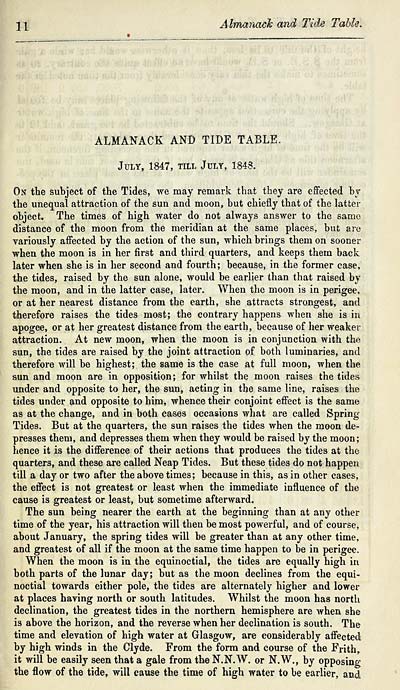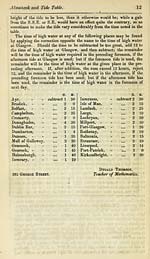Download files
Complete book:
Individual page:
Thumbnail gallery: Grid view | List view

2][ Almayiach mid Tide TahU.
ALMANACK AND TIDE TABLE.
July, 1847, till July, 1848.
On the subject of the Tides, we may remark that they are effected by
the unequal attraction of the sun and moon, but chiefly that of the latter
object. The times of high water do not always answer to the same
distance of the moon from the meridian at the same places, but are
variously affected by the action of the sun, which brings them on sooner
when the moon is in her first and third quarters, and keeps them back
later when she is in her second and fourth; because, in the former case,
the tides, raised by the sun alone, would be earlier than that raised by
the moon, and in the latter case, later. When the moon is in perigee,
or at her nearest distance from the earth, she attracts strongest, and
therefore raises the tides most; the contrary happens when she is in
apogee, or at her greatest distance from the earth, because of her weaker
attraction. At new moon, when the moon is in conjunction with the
sun, the tides are raised by the joint attraction of both luminaries, and
therefore will be highest; the same is the case at full moon, when the
sun and moon are in opposition; for whilst the moon raises the tides
under and opposite to her, the sun, acting in the same line, raises the
tides under and opposite to him, whence their conjoint effect is the same
as at the change, and in both cases occasions what are called Spring
Tides. But at the quarters, the sun raises the tides when the moon de-
presses them, and depresses them when they would be raised by the moon;
hence it is the difference of their actions that produces the tides at tlie
quarters, and these are called Neap Tides. But these tides do not happen
tiU a day or two after the above times; because in this, as in other cases,
the effect is not greatest or least when the immediate influence of the
cause is greatest or least, but sometime afterward.
The sun being nearer the earth at the beginning than at any other
time of the year, his attraction will then be most powerful, and of course,
about January, the spring tides will be greater than at any other time,
and greatest of all if the moon at the same time happen to be in perigee.
When the moon is in the equinoctial, the tides are equally high in
both parts of the lunar day; but as the moon declines from the equi-
noctial towards either pole, the tides are alternately higher and lower
at places having north or south latitudes. Whilst the moon has nortli
declination, the greatest tides in the northern hemisphere are when she
is above the horizon, and the reverse when her declination is south. The
time and elevation of high water at Glasgow, are considerably affected
by high winds in the Clyde. From the form and course of the Frith,
it will be easily seen that a gale from the N.N. W. or N.W., by opposing
the flow of the tide, will cause the time of high water to be earlier, and
ALMANACK AND TIDE TABLE.
July, 1847, till July, 1848.
On the subject of the Tides, we may remark that they are effected by
the unequal attraction of the sun and moon, but chiefly that of the latter
object. The times of high water do not always answer to the same
distance of the moon from the meridian at the same places, but are
variously affected by the action of the sun, which brings them on sooner
when the moon is in her first and third quarters, and keeps them back
later when she is in her second and fourth; because, in the former case,
the tides, raised by the sun alone, would be earlier than that raised by
the moon, and in the latter case, later. When the moon is in perigee,
or at her nearest distance from the earth, she attracts strongest, and
therefore raises the tides most; the contrary happens when she is in
apogee, or at her greatest distance from the earth, because of her weaker
attraction. At new moon, when the moon is in conjunction with the
sun, the tides are raised by the joint attraction of both luminaries, and
therefore will be highest; the same is the case at full moon, when the
sun and moon are in opposition; for whilst the moon raises the tides
under and opposite to her, the sun, acting in the same line, raises the
tides under and opposite to him, whence their conjoint effect is the same
as at the change, and in both cases occasions what are called Spring
Tides. But at the quarters, the sun raises the tides when the moon de-
presses them, and depresses them when they would be raised by the moon;
hence it is the difference of their actions that produces the tides at tlie
quarters, and these are called Neap Tides. But these tides do not happen
tiU a day or two after the above times; because in this, as in other cases,
the effect is not greatest or least when the immediate influence of the
cause is greatest or least, but sometime afterward.
The sun being nearer the earth at the beginning than at any other
time of the year, his attraction will then be most powerful, and of course,
about January, the spring tides will be greater than at any other time,
and greatest of all if the moon at the same time happen to be in perigee.
When the moon is in the equinoctial, the tides are equally high in
both parts of the lunar day; but as the moon declines from the equi-
noctial towards either pole, the tides are alternately higher and lower
at places having north or south latitudes. Whilst the moon has nortli
declination, the greatest tides in the northern hemisphere are when she
is above the horizon, and the reverse when her declination is south. The
time and elevation of high water at Glasgow, are considerably affected
by high winds in the Clyde. From the form and course of the Frith,
it will be easily seen that a gale from the N.N. W. or N.W., by opposing
the flow of the tide, will cause the time of high water to be earlier, and
Set display mode to: Large image | Transcription
Images and transcriptions on this page, including medium image downloads, may be used under the Creative Commons Attribution 4.0 International Licence unless otherwise stated. ![]()
| Scottish Post Office Directories > Towns > Glasgow > Post-Office annual Glasgow directory > 1847-1848 > (15) |
|---|
| Permanent URL | https://digital.nls.uk/84343013 |
|---|
| Description | Directories of individual Scottish towns and their suburbs. |
|---|
| Description | Around 700 Scottish directories published annually by the Post Office or private publishers between 1773 and 1911. Most of Scotland covered, with a focus on Edinburgh, Glasgow, Dundee and Aberdeen. Most volumes include a general directory (A-Z by surname), street directory (A-Z by street) and trade directory (A-Z by trade). |
|---|


